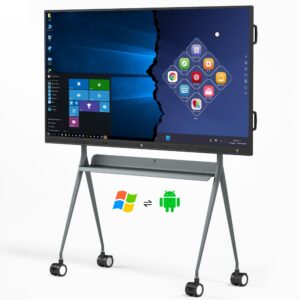Self-Service Payment Kiosk Display is a specialized interactive kiosk system designed to facilitate payment transactions without the need for human intervention. These kiosks typically feature touchscreen interfaces and secure payment processing capabilities, allowing users to make payments for various products and services independently. Self-Service Payment Kiosk Displays are used to streamline payment processes, enhance customer convenience, and reduce waiting times. Let’s explore what a Self-Service Payment Kiosk Display is, why it is used, and where it finds applications:
What is a Self-Service Payment Kiosk Display?
A Self-Service Payment Kiosk Display typically includes the following key components:
- Touchscreen Interface: The kiosk is equipped with a user-friendly touchscreen interface that guides users through the payment process.
- Payment Processing Hardware: It features secure payment processing hardware, such as card readers, EMV chip card readers, NFC (Near Field Communication) technology for mobile payments, and cash receptors.
- Printer: Some kiosks have built-in receipt printers to provide users with transaction receipts.
- Barcode Scanner: For certain applications, such as bill payment, barcode scanners may be included to scan payment-related documents or barcodes.
- Enclosure: The kiosk is housed within a durable and secure enclosure to protect the components and ensure the safety of users’ transactions.
- Connectivity Options: Self-Service Payment Kiosk Displays typically have network connectivity options (e.g., Wi-Fi, Ethernet) for real-time transaction processing and remote monitoring.
Why Use a Self-Service Payment Kiosk Display?
- Efficiency: These kiosks streamline payment processes, allowing customers to make payments quickly and conveniently, reducing waiting times and enhancing operational efficiency.
- Customer Convenience: Self-service payment kiosks offer users the flexibility to make payments at their own convenience, 24/7, without having to wait in long lines or during non-business hours.
- Reduced Human Error: By automating payment processes, self-service kiosks reduce the potential for human errors in manual payment transactions.
- Cost Savings: Businesses and organizations can reduce labor costs by deploying self-service payment kiosks, as they require minimal staff supervision.
- Improved User Experience: Self-service kiosks provide a user-friendly interface that simplifies the payment process, making it more accessible for a wide range of users.
Where Are Self-Service Payment Kiosk Displays Used?
Retail: Retailers use self-service payment kiosks for customers to make in-store payments for purchases, utility bills, and layaway plans.
Bill Payment Centers: Bill payment kiosks are deployed in various locations, including utility company offices and retail outlets, allowing customers to pay bills for utilities, cable, phone services, and more.
Financial Institutions: Banks and credit unions utilize self-service payment kiosks for loan payments, credit card payments, and account deposits.
Parking Facilities: Parking lots and garages deploy self-service payment kiosks to facilitate parking fee payments.
Healthcare: Hospitals and medical clinics use self-service payment kiosks for patients to make co-pays, cover medical expenses, and settle bills.
Government Services: Government agencies implement self-service payment kiosks for citizens to pay fines, taxes, and fees, as well as renew licenses and permits.
Transportation: Public transportation systems, including buses and subway systems, have self-service payment kiosks for ticket purchases and fare payments.
Entertainment Venues: Movie theaters, theme parks, and concert venues use self-service payment kiosks for ticket sales and concessions.
Hospitality: Hotels and resorts may have self-service payment kiosks for guests to settle room charges, spa services, and restaurant bills.
Educational Institutions: Colleges and universities deploy self-service payment kiosks for students to pay tuition fees, housing expenses, and other educational costs.
Self-Service Payment Kiosk Displays are valuable tools for businesses and organizations seeking to improve payment processes, enhance customer satisfaction, and optimize operational efficiency. As technology continues to advance, these kiosks may incorporate additional features, such as biometric authentication and mobile wallet integration, to further enhance security and convenience for users.
Food and Beverage: Restaurants, cafeterias, and fast-food establishments implement self-service payment kiosks to enable customers to place orders, customize meals, and make payments at their own pace.
Self-Checkout in Retail: Many retail stores offer self-service checkout kiosks, allowing shoppers to scan and pay for their items without assistance from store staff.
Car Rental and Car Wash: In the automotive industry, self-service payment kiosks are used for car rental payments, car wash fees, and parking fees at rental lots.
Self-Service Check-In: Airlines and hotels utilize self-service payment kiosks for travelers to check in, select seats, and make additional purchases like baggage fees and upgrades.
Vending Machines: Modern vending machines often incorporate self-service payment kiosks, accepting various forms of payment, including credit cards and mobile payments.
Self-Service Tax Filing: Tax preparation services offer self-service payment kiosks for clients to pay their tax bills and associated fees.
Self-Service Printing: Printing and document centers deploy self-service payment kiosks for customers to print, copy, and scan documents, paying for these services through the kiosk.
Parking Ticket Payment: Municipalities and parking authorities use self-service payment kiosks for citizens to pay parking fines and fees conveniently.
Gaming and Entertainment: Casinos and gaming establishments provide self-service payment kiosks for patrons to load gaming credits and cash out their winnings.
Charity and Donation Kiosks: Nonprofits and charitable organizations place self-service payment kiosks in high-traffic areas to collect donations for various causes.
Theme Park and Amusement Park Payments: Theme parks use self-service payment kiosks for ticket purchases, season pass renewals, and locker rentals.
Membership Renewal: Gyms, clubs, and membership-based organizations offer self-service kiosks for members to renew subscriptions and pay dues.
Prepaid Card Reloads: Kiosks enable customers to reload prepaid cards for services like mobile phones, transit, and gift cards.
Event Registration: At conferences and trade shows, self-service payment kiosks are used for attendee registration and payment processing for conference fees.
Self-Service Ordering for Takeout and Delivery: Restaurants and food delivery services deploy self-service payment kiosks for customers to place orders and make payments for takeout and delivery.
Library Fine Payment: Libraries use self-service payment kiosks for patrons to settle fines, fees, and printing charges.
Retail Returns and Refunds: Retailers with flexible return policies may offer self-service kiosks for customers to process returns and receive refunds.
Government Services: Government agencies use self-service payment kiosks for citizens to pay for various government services, including permits, licenses, and fines.
Self-Service Bike and Scooter Rentals: In urban areas, self-service payment kiosks facilitate bike and scooter rentals for short-distance transportation.
Hotel Express Checkout: Some hotels offer express checkout through self-service payment kiosks, allowing guests to settle their bills quickly.
Self-Service Payment Kiosk Displays continue to gain popularity across a wide range of industries and sectors due to their ability to enhance customer convenience, reduce transaction time, and improve overall operational efficiency. These kiosks are evolving with technology trends, including contactless payment options, mobile wallet integration, and advanced security features, making them even more versatile and valuable in various payment scenarios.
Contactless and Mobile Payments: With the increasing popularity of contactless payment methods and mobile wallets like Apple Pay and Google Pay, self-service payment kiosks are adapting to offer these convenient and secure payment options.
Receipt Options: Many self-service payment kiosks allow users to choose their preferred receipt delivery method, such as email or text message, reducing paper waste and providing a digital record of the transaction.
Enhanced Security Measures: Kiosk providers are continually improving security features, including encryption and tokenization, to safeguard user payment data and protect against fraud.
Integration with Loyalty Programs: Some self-service payment kiosks offer integration with loyalty and rewards programs, allowing customers to earn points, discounts, or special offers with their transactions.
Self-Service Account Management: Beyond payments, these kiosks are expanding to offer users the ability to manage their accounts, view transaction history, and update personal information.
User Analytics: Businesses and organizations are leveraging data analytics to gain insights into user behavior and preferences, enabling them to optimize kiosk placement and content strategies.
Self-Service Ordering for Customization: In the food industry, self-service payment kiosks enable customers to customize their orders, from burger toppings to coffee preferences, enhancing the dining experience.
Interactive Advertising: Self-service payment kiosks can display targeted advertisements and promotions, generating additional revenue for businesses and providing users with relevant offers.
Remote Monitoring and Support: Kiosk operators can remotely monitor the performance of self-service payment kiosks, diagnosing issues and performing maintenance without the need for on-site visits.
Integration with Inventory Management: In retail environments, kiosks can be integrated with inventory management systems, allowing users to check product availability and place orders for out-of-stock items.
Queue Management: Self-service payment kiosks with queue management features enable users to join virtual queues, reducing physical wait times and enhancing the overall customer experience.
Compliance with Regulatory Standards: Kiosk providers are staying up-to-date with regulatory standards, such as PCI DSS (Payment Card Industry Data Security Standard), to ensure secure payment processing.
Multilingual Support: To cater to diverse user populations, self-service payment kiosks often offer multilingual support, allowing users to select their preferred language for the transaction.
Integration with E-commerce: Some businesses use self-service payment kiosks as an extension of their e-commerce platforms, providing customers with an additional payment channel.
Integration with CRM Systems: Integration with Customer Relationship Management (CRM) systems allows businesses to track customer interactions and tailor their offerings accordingly.
As self-service payment kiosk technology continues to evolve, businesses and organizations are finding innovative ways to leverage these solutions to enhance customer experiences, reduce operational costs, and drive revenue growth. Whether it’s in traditional retail settings, the food industry, healthcare, or various other sectors, self-service payment kiosks are becoming increasingly integral to modern payment and service delivery processes.




